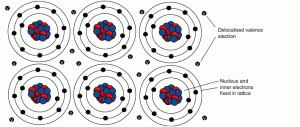Christmas Science: We Three Kings: Gold, Frankincense and Myrrh
International GCSE Chemistry 1g Covalent substances, 1h Metallic crystals
Three highly prized gifts two millennia ago given by the three Kings. A scientific analysis follows of the structure of gold, frankincense and myrrh…and still a little mystery
Gold is an unusual metal in that it is bright yellow and so unreactive that it is possible to find it as gold deposits. Most other metals need extracting from an oxide ore. In common with all metals it has a characteristic structure. The nucleus of each atom and the inner electrons which orbit it (called cations) are arranged in a regular lattice structure. The outermost electrons (called the valence electrons) are free to move throughout the lattice structure. We say that they are delocalised.
The delocalised electrons are the reason that all metals are shiny. The structure of metals also explains why metals are so malleable (bendable). The layers in the lattice can slide over each other without the metal breaking. Two thousand years ago, the ability to find and work a metal without first having to extract it in a furnace was most desirable!
Frankincense and myrrh are both resins collected from trees. The bark and sapwood of the tree are cut and the resin seeps out and hardens. The resin is a mixture of large organic molecules. These molecules contain hydrogen, carbon and oxygen. The atoms are covalently bonded together. The smaller molecules are the most volatile, and will evaporate and give a characteristic aroma to the resin when it is warmed.
This is a molecule of boswellic acid, one of the components of frankincense.
|
So, what of the mystery still surrounding these gifts? Gold is so dense that any gold formed early in the earth’s existence has sunk and has long been part of the earth’s core. It is thought that all the gold we find in the crust has come from asteroid impacts. As for the resins, collected from wounded trees, the reason the plants produce them is not fully agreed upon. They may be a form of excretion by the plant of waste metabolites, or they could be produced for the purpose of protection against pathogens.
